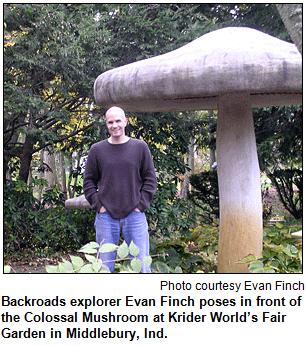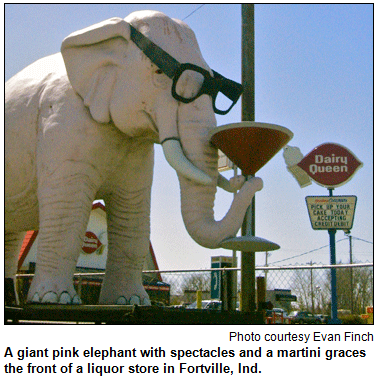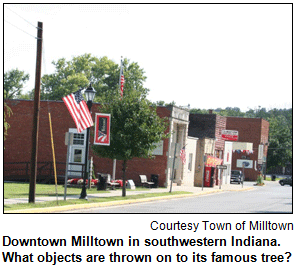May 10 show
Offbeat landmarks across Indiana
 "I like weird stuff," says Evan Finch of Indianapolis. "I like history. And I like to drive around. On some weekends, I get to combine all three by driving around, finding unusual things and learning their histories."
"I like weird stuff," says Evan Finch of Indianapolis. "I like history. And I like to drive around. On some weekends, I get to combine all three by driving around, finding unusual things and learning their histories."
So Evan, an advertising copywriter who describes himself as a "dilettante" historic preservationist, has visited and will share insights about such offbeat or funky Hoosier landmarks as the Big Peach near the Knox County town of Bruceville and the Colossal Mushroom near Middlebury in Elkhart County. Evan describes the former as "a gigantic, eye-luring, concrete-and-chicken-wire" peach built in the 1950s to attract attention to a farm stand.
Also on the menu for our show: An exploration of the Giant Egg near Mentone, a town in far-northern Indiana that promotes itself as the "egg basket" of the Midwest. According to Evan, the town built a 10-foot-tall, 3,000-pound egg in 1946 to advertise its annual egg festival.
With Evan, a copywriter for Young & Laramore, we won't limit ourselves to food-shaped landmarks.  He will share insights about the sculpture of a giant serpent created by a stone cutter who lived on a farm near Needmore. The cutter, August Mack, was a German immigrant whose dream about a snake inspired him to create the mechanical serpent, which, as Evan puts it, "could move, hiss, rattle and open its mouth."
He will share insights about the sculpture of a giant serpent created by a stone cutter who lived on a farm near Needmore. The cutter, August Mack, was a German immigrant whose dream about a snake inspired him to create the mechanical serpent, which, as Evan puts it, "could move, hiss, rattle and open its mouth."
Promoted on a billboard, the giant snake became a roadside attraction during the 1930s and '40s, with its creator charging a modest admission to see it. Alas, the serpent landmark - unlike most of the others we will explore - apparently no longer exists. Evan will explain why during the show.
Other landmarks Evan will discuss include:
- The gravesite of Johnny Appleseed (real name: John Chapman) in Fort Wayne. Chapman (1774-1845) was the focus of a Hoosier History Live! show in November 2009 that featured an expert guest: Indianapolis-based playwright Hank Fincken, who portrays the Hoosier folk hero and other historic figures at events across the country.
- A statue of Joe Palooka (a once-popular comic strip character) that also was the brainstorm of southern Indiana stonecutters.
 Created by two of them and dedicated in Bedford in 1948, the Palooka statue has been moved several times but has stood in the town of Oolitic for more than 30 years. Noting that the statue is 10 feet tall, Evan observes: "He's a big Palooka.”
Created by two of them and dedicated in Bedford in 1948, the Palooka statue has been moved several times but has stood in the town of Oolitic for more than 30 years. Noting that the statue is 10 feet tall, Evan observes: "He's a big Palooka.”
- And the largest preserved steer in the world. Known as "Old Ben," the steer has been displayed in Kokomo for decades. His weight upon his death was estimated at more than 4,500 pounds.
Never heard of Joe Palooka? The comic strip that featured the character - a muscle-bound, lantern-jawed boxer described as dumb but well-intentioned - ended in 1984.
The comic was in its heyday in 1948, though. That's when, according to some accounts, more than 4,000 people attended the dedication of the limestone Joe Palooka. It's 10 feet tall, weighs 10,000 pounds and can be found on Main Street in Oolitic near the town's post office.
 "I'm interested in anything unique, that makes one place different from any other place," our guest Evan Finch explained during a recent presentation about his "quirky landmarks" passion at Indiana Landmarks, the historic preservation organization. "Finding those differences makes life seem more mysterious and more fun."
"I'm interested in anything unique, that makes one place different from any other place," our guest Evan Finch explained during a recent presentation about his "quirky landmarks" passion at Indiana Landmarks, the historic preservation organization. "Finding those differences makes life seem more mysterious and more fun."
Surely the Colossal Mushroom qualifies as unique. According to Evan, the mushroom is one of several decorative structures constructed by the owner of a Middlebury nursery to promote his business at the 1933 World's Fair in Chicago. The eye-catching mushroom and other structures constructed by Krider Nurseries were displayed in gardens at the World's Fair.
"After the fair was over in 1934, Krider didn't want to lose all of their investment ... so they bought a lot of it back and reconstructed the garden in Middlebury," Evan reports.
 Although Krider went out of business more than 20 years ago, the mushroom remains as a towering figure in a community park.
Although Krider went out of business more than 20 years ago, the mushroom remains as a towering figure in a community park.
Equally colorful is the history of another roadside oddity that Evan will discuss. For several decades in Terre Haute, teenagers and other residents visited a family mausoleum to see "Stiffy Green," a bulldog that had been, as Evan puts it, "taxidermied."
Creeping around the mausoleum at Highland Lawn Cemetery at night became a Terre Haute rite of passage, Evan says. Terrified teenagers would shine flashlights at the bulldog to glance at its glowing eyes. Vandalism of Stiffy Green during the 1980s, though, resulted in moving the once-beloved pet from the cemetery to the basement of the Vigo County Historical Museum. In the basement, the bulldog sits in a replica of the family crypt.
During his Landmarks presentation, Evan likened the visits to Stiffy Green's mausoleum to a rite of passage for generations of teenagers in the Indianapolis area: Nocturnal visits to the bygone House of Blue Lights owned by eccentric millionaire Skiles Test.
During back-to-back Halloween seasons - in October of 2009 and 2010 - we broadcast Hoosier History Live shows about various aspects of the House of Blue Lights urban legend. The 2010 show featured a rare interview with Test's daughter, Louellen Test Hesse.
Roadtrip: Home plate at Butler University
Guest Roadtripper Jason Lantzer, author, past Hoosier History Live! guest, and director of Butler's Honors Program, will talk about this mysterious home-plate marker on Butler's campus in front of Jordan Hall. It's baseball season, so learn more about this historic athletic milestone on the show this Saturday!
History Mystery
A tree near the small town in southwestern Indiana of Milltown has become a roadside attraction because of what people fling onto its branches.  During the early 1960s, a group of Boy Scouts may have started the tradition of tossing the items onto the tree. For more than 50 years since then, people have thrown this object onto the tree. As a result, the tree has been featured in books, newspaper articles and TV and radio reports.
During the early 1960s, a group of Boy Scouts may have started the tradition of tossing the items onto the tree. For more than 50 years since then, people have thrown this object onto the tree. As a result, the tree has been featured in books, newspaper articles and TV and radio reports.
Question: What have hundreds of people tossed onto the tree?
The call-in number is (317) 788-3314. Please do not call into the show until you hear Nelson pose the question on the air, and please do not try to win the prize if you have won any other prize on WICR during the last two months.
The prize is a gift certificate to Arni's Restaurant, courtesy of Visit Indy, and four passes to the Indiana Experience, courtesy of the Indiana Historical Society, and a pair of passes to Glow Golf, the miniature golf course at the Circle Centre Mall, courtesy of Glow Golf.
Your Hoosier History Live! team,
Nelson Price, host and creative director
Molly Head, producer, (317) 927-9101
Richard Sullivan, webmaster and tech director
Pam Fraizer, graphic designer
Garry Chilluffo, creative consultant
Joan Hostetler, Michele Goodrich, Jed Duvall, Dana Waddell, advisors
www.hoosierhistorylive.org






Please tell our sponsors that you appreciate their support: Indiana Historical Society | Indiana Landmarks | Lucas Oil | Story Inn | The Fountain Square Theatre Building | Young & Laramore

 Acknowledgments to Monomedia, Visit Indy, WICR-FM, Fraizer Designs, Heritage Photo & Research Services, Derrick Lowhorn and many other individuals and organizations. We are an independently produced program and are self-supporting through organizational sponsorships and individual contributions. We do not receive any government funding. Visit our website to learn how you can support us financially. Also, see our Twitter feed and our Facebook page for regular updates.
Acknowledgments to Monomedia, Visit Indy, WICR-FM, Fraizer Designs, Heritage Photo & Research Services, Derrick Lowhorn and many other individuals and organizations. We are an independently produced program and are self-supporting through organizational sponsorships and individual contributions. We do not receive any government funding. Visit our website to learn how you can support us financially. Also, see our Twitter feed and our Facebook page for regular updates.
May 17 show - encore presentations
Slave trials in 1820s and Fairmount town history: Two classic shows
Instead of a one-hour program, Hoosier History Live will broadcast two back-to-back half-hour shows from our archives of nearly 300 programs. We have selected two of the most popular programs in our more than six years of covering all aspects of our Hoosier heritage.
Slave trials in 1820s
 During the first classic show (original air date: Nov. 13, 2010), we explore how a young African-American woman in Vincennes made history in 1821. A lawyer for Mary Bateman Clark filed a lawsuit seeking her release from an "indentured servitude" contract with one of the most prominent men in the new state of Indiana. The contract required Mary to cook, clean and sew for Gen. Washington Johnston and his family for 20 years. He only pay was housing, food and clothing.
During the first classic show (original air date: Nov. 13, 2010), we explore how a young African-American woman in Vincennes made history in 1821. A lawyer for Mary Bateman Clark filed a lawsuit seeking her release from an "indentured servitude" contract with one of the most prominent men in the new state of Indiana. The contract required Mary to cook, clean and sew for Gen. Washington Johnston and his family for 20 years. He only pay was housing, food and clothing.
The case, which made its way to the Indiana Supreme Court, involved determining whether such "indentured servitude" contracts violated the state's constitution as a form of slavery. The Supreme Court ruled in Mary's favor and ordered her employer to release her.
To share insights about the social history of the era and the landmark case, Nelson is joined in studio by one of Mary's descendants, Indianapolis resident Eunice Trotter. Eunice, a veteran journalist, and her sister Ethel McCane are using their research about their ancestor to do "living history performances" for schools and civic groups across the state. They can be contacted through their website at marybatemanclark.org.
 Eunice and Ethel crusaded for a historic marker in honor of Mary Bateman Clark; it was dedicated at the Knox County Courthouse in 2009. The sisters are Mary Bateman Clark's great-great-great granddaughters.
Eunice and Ethel crusaded for a historic marker in honor of Mary Bateman Clark; it was dedicated at the Knox County Courthouse in 2009. The sisters are Mary Bateman Clark's great-great-great granddaughters.
According to their research, many white residents of Vincennes and other early Indiana communities worried about the presence of free African-Americans, fearing they would incite indentured blacks.
Fairmount town history
 You may know that movie icon James Dean grew up on a farm near the Grant County town of Fairmount.
You may know that movie icon James Dean grew up on a farm near the Grant County town of Fairmount.
But were you aware the creator of the most widely syndicated comic strip in the world also grew up on a Fairmount farm? It was the boyhood home of Jim Davis, creator of Garfield, the cantankerous cat.
To explore the heritage of a town with several distinctions during our second classic show (original air date: Aug. 28, 2010), Nelson is joined in studio by Fairmount resident Cathy Duling Shouse, the author of a visual history book about her hometown, Fairmount, part of Arcadia Publishing's "Images of America" series. Cathy's ancestors settled in the Fairmount area before 1850.
 In her book, which she put together with the Fairmount Historical Museum, more than half of the 223 rare vintage photos came from private collections of local residents.
In her book, which she put together with the Fairmount Historical Museum, more than half of the 223 rare vintage photos came from private collections of local residents.
The images include a 1904 photo of the construction of the Winslow family farmhouse, where young James Dean was raised during the 1930s and '40s by his aunt and uncle.
There are also photos of Lake Galatia near Fairmount, which was formed by the last glacier. Lake Galatia is where, as Cathy puts it, "the most complete set of mammoth bones ever found was discovered." That was in 1904. The discovery of the huge skeleton of the mammoth (which apparently lived 11,000 years ago) sparked a lawsuit about their ownership.
Initially part of the Miami Indian territory, Fairmount was settled early on by Quakers. Fun fact: The mascot of old Fairmount High School - where James Dean, a member of the Class of 1949, was a standout basketball player - was "the Quakers."
© 2014 Hoosier History Live! All rights reserved.